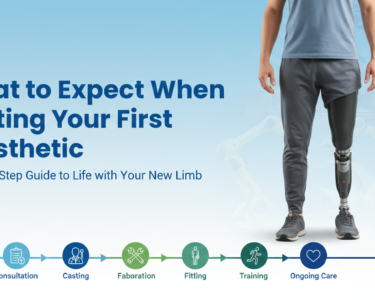Prosthetic limbs have helped millions of people around the world regain mobility and independence after losing a limb. For people with diabetes, amputation is sometimes a serious complication due to poor blood circulation, infections, or unhealed wounds. In such cases, prosthetic limbs can be life-changing. But a common question many people ask is: Are prosthetics safe for diabetic patients?
The short answer is yes, prosthetics can be safe for diabetic patients—but with some important considerations. In this article, we’ll break down what diabetic patients need to know about using prosthetic limbs safely, what risks to watch for, and how to take care of their residual limb (the remaining part of the limb after amputation).
Why Diabetics May Need Prosthetics
Diabetes can affect the body in many ways, especially the nerves and blood vessels. Over time, high blood sugar can lead to:
- Peripheral neuropathy (nerve damage), which reduces sensation in the feet or hands.
- Poor circulation, making it hard for wounds to heal.
- Foot ulcers or infections, which sometimes become so serious that amputation is necessary.
If an amputation occurs, a prosthetic limb may be recommended to help the person walk again or carry out daily tasks.
Can a Diabetic Person Use a Prosthetic Limb?
Yes, many diabetic patients successfully use prosthetic limbs. However, they need to be extra careful because diabetes makes the skin and tissues more sensitive and slower to heal. This means that any small problem with the prosthetic—like too much pressure, friction, or a poor fit—can lead to complications such as wounds or infections.
That’s why diabetic users need special attention during every stage of the prosthetic journey.
What Makes Prosthetic Use Risky for Diabetic Patients?
Here are some of the main challenges or risks:
1. Loss of Sensation
Many diabetic patients have nerve damage, meaning they can’t feel pain, pressure, or heat well in their feet or legs. This can be dangerous because:
- A poorly fitting prosthetic might cause a blister or sore.
- The patient might not notice the wound until it becomes serious.
2. Slow Healing
Even a small injury can take a long time to heal if blood flow is poor. This increases the risk of infection, and in some cases, it can lead to further amputation if not treated early.
3. Skin Problems
Diabetic skin tends to be dry and sensitive. Rubbing, sweating, or pressure from the prosthetic socket can lead to:
- Skin irritation
- Ulcers or open wounds
- Fungal or bacterial infections
How to Use Prosthetics Safely with Diabetes
Here are the key steps diabetic patients should follow to safely use and benefit from prosthetics:
1. Work with a Skilled Prosthetist
Choose a certified and experienced prosthetist who understands diabetic needs. They will:
- Create a custom socket that fits the residual limb perfectly.
- Choose soft liners and padding to protect sensitive skin.
- Make regular adjustments as the limb changes shape.
2. Check the Residual Limb Daily
Every day, the user (or a caregiver) should inspect the limb for:
- Redness
- Blisters
- Cuts or sores
- Swelling or warmth (sign of infection)
Using a mirror can help check hard-to-see areas. If any issue is found, they should remove the prosthetic and contact a doctor or prosthetist right away.
3. Keep Skin Clean and Moisturized
- Wash the residual limb with warm (not hot) water and mild soap.
- Dry thoroughly, especially between folds.
- Use diabetic-friendly moisturizers to prevent dryness and cracking.
Avoid applying lotion directly before wearing the prosthesis, as it may cause slippage or irritation.
4. Wear Clean Liners and Socks
- Always wear clean, dry prosthetic socks and liners.
- Change them daily or more often if they become wet from sweat.
- Use liners that are breathable and suitable for sensitive skin.
5. Manage Blood Sugar Levels
Keeping blood sugar under control helps:
- Improve circulation
- Speed up wound healing
- Prevent nerve damage from getting worse
A healthy diet, regular exercise, and prescribed medications are key to good diabetes management.
6. Regular Medical Checkups
- Visit a doctor or foot specialist (podiatrist) regularly.
- Schedule appointments with your prosthetist for socket adjustments.
- Don’t wait for pain—prevention is better than cure.
Specialized Prosthetics for Diabetic Users
There are prosthetic components designed specifically for people with diabetes:
- Soft inner liners to reduce pressure points.
- Lightweight materials that reduce stress on the limb.
- Pressure-relief sockets with special cushioning.
- Microprocessor-controlled feet that offer more stability and adjust automatically to uneven ground.
Using these advanced features can make a big difference in comfort and safety.
Benefits of Prosthetics for Diabetic Patients
Despite the risks, the benefits are huge when the prosthetic is used correctly:
- Improved mobility and independence.
- Reduced risk of other health problems caused by immobility.
- Better mental health and quality of life.
- Ability to return to work or favorite activities.
Many diabetic amputees go on to live full and active lives—with the right care and support.
Final Thoughts
Remember: the prosthetic limb is not just a tool—it’s part of your body now. Treat it with care, listen to your body, and work closely with your healthcare team. With the right steps, it’s absolutely possible to walk, move, and live life confidently as a diabetic amputee.
So, are prosthetics safe for diabetic patients? Yes, they are—but only with proper care, expert guidance with trusted prosthetics manufacturer in India and ongoing attention to limb health.Diabetic users need to be more cautious than others, but with the right support team, good hygiene, and regular check-ups, they can safely wear and benefit from a prosthetic limb.
Disclaimer: The information provided in this article is for general knowledge and educational purposes only. It should not be considered medical advice, diagnosis, or treatment. Prosthetic solutions vary based on individual needs, medical conditions, and professional recommendations. Always consult with a certified prosthetist, healthcare provider, or medical professional for personalized advice and the best prosthetic options for your specific situation.








